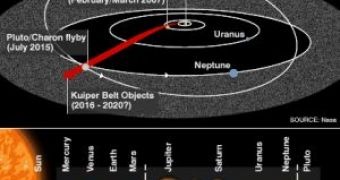One year after its dispatch, NASA's The New Horizons spacecraft is on the doorstep of Jupiter, at 2,3 million km distance, on its way towards Pluto.
This space mission is already the fastest ever launched, and Jupiter's gravity will speed it with some additional 9,000 miles per hour, ensuring its arrival at the dwarf Pluto by 2015.
New Horizons has already captured more than 20 images of Jupiter and more than 700 are planned by the end of a late February.
"This is a big test for our mission," said Alan Stern, from the Southwest Research Institute, Boulder, Colorado, and the principal investigator on the NASA mission.
"We specifically want to exercise the spacecraft hard enough so we turn up any small vulnerabilities or weaknesses, either in our ground planning or in the bird in flight."
"We are really looking forward to being the next mission to Jupiter and my team is rabid to work with the data as soon as we can get it on the ground."
The kick given to New Horizons by Jupiter will increase its speed to 84,000km/h (52,000 mph), saving by four years the time necessary for reaching Pluto.
The probe will also investigate Jupiter's four largest moons - Io, Europa, Ganymede, and Callisto.
The observations on Jupiter will continue 'till June.
Astronomers are very interested in getting information about Jupiter's turbulent, stormy atmosphere and its ring system and the long "tail" of Jupiter's magnetosphere, a large stream of charged particles extending tens of millions of km beyond the planet.
"All the plasma that is put out by the volcanoes on Io ultimately escapes down this tail, and no spacecraft has flown down this region before; it's real terra incognita," explained New Horizons science team member Dr John Spencer.
"There's not much to see there, but there is a great deal for the plasma instruments to sense."
Much of the data from the Jupiter flyby will not be sent back to Earth immediately.
Some of the obtained data will be stored and sent to Earth after the day of closest approach to Jupiter on 28 February.
The next years, New Horizons will be cruising towards Pluto, being checked annually for technical problems and rehearsals for Pluto's exploration.
By July 2015, the first detailed maps of Pluto and its biggest moon Charon will be available.
The maps will also depict spot haze, rings and surfaces.
The spacecraft will also measure ultraviolet emissions from Pluto.
New Horizons will pass to about 10,000km (6,200 miles) from Pluto and about 27,000km (16,800 miles) from Charon, before pressing onwards.
The spacecraft could also travel on the Kuiper Belt, a space region compassing many frozen leftovers from the Solar System emergence.
"Going to Pluto and the Kuiper Belt is very new; it's the new frontier," said Dr Stern.
"It's opening up both a window on the deep outer Solar System and a window back in time, 4.5 billion years to the birth of the planets."

 14 DAY TRIAL //
14 DAY TRIAL //